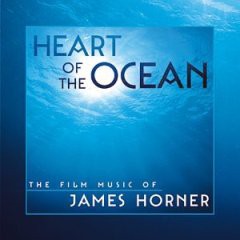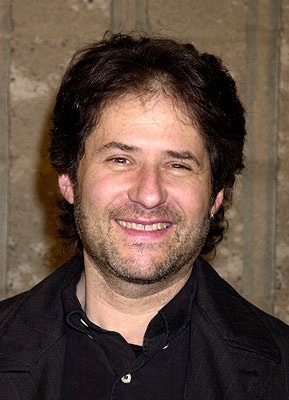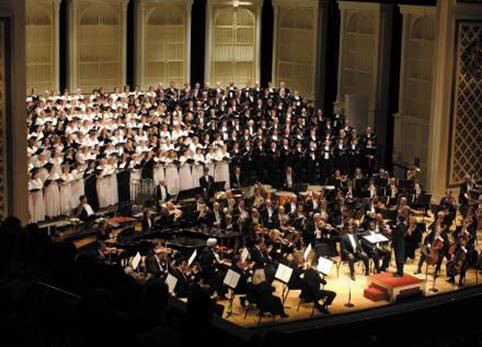
James Horner
Heart Of The Ocean (The Film Music Of James Horner)
Compil. US 1998 on Sonic Images Records label
Classical and Soundtrack (Score)
(P)(C) Sonic Images Records, A Division of Sonic Images Enterprises Booklet Liner Notes: "HEART OF THE OCEAN, About The Film Music Of James Horner, by Randall D. Larson Film composers, as a rule, do not achieve stardom. They rarely become household names. Scoring movies remains a misunderstood and often neglected art. Even with the growing marketability of soundtrack CDs from films (as distinct from a collection of songs used in a film), film music is appreciated as music - apart from its serviceability as one of many components of a motion picture - by relatively few. It's only when the popularity of a film transcends the commodity of the neighborhood theater or video store that its music really falls into the cultural language. Henry Mancini was one of the first composers to achieve fame based on his popular compositions for films, many of which have gone on to become musical standards. John Williams revitalized symphonic film scoring in an era of pop-music affluence in the late 1970s and made possible dozens of film music careers in the two decades that followed. James Horner's was one of them. Emerging from the low-budget world of Roger Corman horror and science fiction in 1979, Horner has gone on to score many of the most popular films of the last 20 years. And, with the resonant success of his score for TITANIC coupled with the commercial and critical success of the film itself, James Horner is finding himself among that rare gathering of film composers whose names are recognized even by the most casual moviegoers. "Oh, James Horner," they will murmur upon reading the name on a movie poster or during the opening credits of a new film. "He wrote the music for TITANIC." "Oh, yes, that's right...!" TITANIC is the crowning achievement of a career that has spanned 20 years and more than a hundred movies, garnering an Oscar, a Golden Globe and three Grammy Awards, and a fistful of Academy Award and Golden Globe nominations along the way. The TITANIC soundtrack album, at more than 268,000 sold, has become one of the best selling original score soundtracks ever. It topped Billboard's list of top-selling CDs for a record-setting 15 weeks, eclipsing the mark of 14 set by EXODUS 36 years ago. James Horner's meteoric rise to fame and success came quickly and came young for the 44-year old composer/conductor. In an occupation increasingly difficult to acquire, where a hopeful musician can get a degree in Film Composition and then face relentless competition from hundreds of other hopeful musicians eager for a shot at a Hollywood filmscoring career, Horner briskly rose like one of Titanic's brilliant and dazzling flare beacons from low budget suburbia to the top of his craft in a handful of years. Early on, his music reached an emotional connection with moviegoers. He demonstrated an instinctive ability to identify a film's emotional core through music which, indeed, is movie music's highest calling. It is the job of the film composer to weave that final emotional link between celluloid and cinemagoer, making that subliminal connection between the character on screen and the emotions of the viewer in the audience. In short, music - the very last component of film to be integrated into the cinematic whole - has the vitally important mission of linking all of the other components. Music - the language of emotions - consummates the performances of the actors on screen, and it colors the events and environments in which writers and cinematographers and set designers and directors have placed them. Music accomplishes this almost magically. James Horner, with his mastery of stirring melodies, potent orchestrations, and profoundly moving crescendos and decrescendos, has become a master at emotive film scoring. He finds - or he invents - a film's passionate core; then he emphasizes, embellishes, and envelops that core with music. Horner's film scores create and maintain that emotional link between the viewer and the visual story played out on the theater or video screen with splendid and often very me- morable effectiveness. Born in Los Angeles in 1953, James Horner spent his formative years in London where he attended the prestigious Royal Academy of Music with the aim to become a composer of serious, avant-garde classical music. Returning to his native California, he continued his musical education at the University of Southern California where he received a Bachelor of Music in Composition. He transferred to the masters program at UCLA where he earned a Doctorate in Music Composition and Theory. An offer to score a short film for the American Film Institute in the late ‘70s led to the dis- covery of a passion for film music. After scoring a number of films for the AFI, Horner left the academic world and began developing his craft in the low-budget milieu of Roger Corman's New World Pictures. During his sojourn at New World, Horner also became acquainted with a number of young directors, including Ron Howard and James Cameron, with whom he would later collaborate very successfully. His career was weaned on such classics as UP FROM THE DEPTHS, HUMANOIDS OF THE DEEP, and BATTLE BEYOND THE STARS. Fluffy and forgettable fantasies, the movies were nevertheless notable for containing effective symphonic scores composed by the hitherto unknown Horner. Graduating to larger horror films like WOLFEN, THE HAND, and DEADLY BLESSING, Horner found additional opportunities to ply his trade and concoct film scores of increasing interest. Propelled into the film music mainstream with his big-budget scores for big-budget films like STAR TREK II: THE WRATH OF KHAN and ALIENS, Horner very quickly found him- self at the forefront of Hollywood film scoring. The success of the STAR TREK scores initially pigeon-holed Horner in the science fiction/fantasy realm with pictures like BRAINSTORM, KRULL, and SOMETHING WICKED THIS WAY COMES. With opportunities to score other types of films, such as 48 HOURS, UNCOMMON VALLOR, and GORKY PARK, Horner extricated himself from being a "genre composer" and propelled a career that has made him one of the most sought-after film composers in Hollywood. Name a dozen of the decade's biggest films - half of them may well have been scored by Horner. The variety of subject matter, period, and locale has also afforded Horner the opportunity to compose music in a wide variety of styles. BRAVEHEART carries a strong Irish and Scottish tonality as benefits its historical setting. TITANIC based much of its thematic material on Irish music, associated with the Irish laborers who built the mighty vessel. Steel drums have their place in 48 HOURS. Andean flutes occupied much of the music to VIBES while synthesizers gave FIELD OF DREAMS an ethereal and visionary tonality. SWING KIDS featured plenty of 1940's big band swing complementing the inclination of certain World War II-era German youth toward jazz music instead of the Third Reich. HONEY, I SHRUNK THE KIDS and both COCOON movies featured their share of big band swing as well, contrasted with COCOON's poignant melodies associated with its characters both human and unearthly. Electronic and vocal intonations lent a quasi-medieval texture to THE NAME OF THE ROSE. ALIENS featured a claustrophobic score full of surging dissonance and rapid, assaultive orchestral motion. CASPER used choir to emphasize its ghostly relations. THE ROCKETEER carried a gentle sense of Americana as it supported the story of a steel- clad super-hero battling Nazis on America's home front during World War II. THE MAN WITHOUT A FACE, THE SPITFIRE GRILL, SEARCHING FOR BOBBY FISCHER, and WHERE THE RIVER RUNS BLACK were provided with smaller, gentler melodic scores while blockbusters like RANSOM and JUMANJI received energetic, bombastic orchestrations. COMMANDO, PATRIOT GAMES, and A CLEAR AND PRESENT DANGER were brisk action scores, ripe with percussive excitement and heroic melodies. LEGENDS OF THE FALL captured one of Horner's most expansive themes, filled with simple Americana and a profound melody line. GLORY featured a boy's choir creating a passionate hymn, embodying all the futile heroism and indomitable spirit of the 54th Regiment of Massachusetts during the Civil War. COURAGE UNDER FIRE captured a similar sense of poignancy as it explored notions of courage, bravery, and accountability during a moment (replayed from diverse perspectives in the search for truth) in the Gulf War. APOLLO 13 captured all of the glory, the sense of achievement, and the sheer desperation of the predicament experienced by the American astronauts in the near-tragedy of the NASA space program. Animated musicals like AN AMERICAN TAIL, THE LAND BEFORE TIME, and WE'RE BACK - A DINOSAUR'S STORY were tuneful and melodic. THE PAGEMASTER, with its amalgamation of animation and live-action, received a thunderous action score befitting any full-blooded adventure. WILLOW gave its live-action cartoon story plenty of breezy, string-driven adventurism. What all of these film scores have in common is a grounding in tonality and melody and a rich emotional tapestry which accentuates the drama depicted in the films. The fact that most of them also contain highly melodic music that stands on its own apart from the films is a credit to the composer and the durability of superior motion picture scoring. About the Author: Randall D. Larson is a senior editor for "Soundtrack! The Collector's Quarterly," and the former editor/publisher of "CinemaScore - The Film Music Journal", which covered movie music in voluminous detail from 1979-1987. A music columnist for Cinefantastique magazine for more than 15 years, Larson is also the author of several books on film music including Music From The House of Hammer and Musique Fantastique: A Survey of Film Music in the Fantastic Cinema."
Musicians
 | James Horner key, 1953-2015 US album by, conductor |
 | Mark Northham , piano |
 | Bill Broughton tb, conductor |
 | Orchestra Of The Americas , orchestra |
 | John Beal , arranged by, performer |
 | Erich Kunzel , 1935-2009 US conductor |
 | Cincinnati Pops Orchestra , US orchestra |
 | William Motzing , 1937-2014 AU conductor |
 | The City Of Prague Philharmonic , orchestra |
 | Goetz Steeger perc, AT arranged by |
 | Gunther Laudahn hrp, DE arranged by |
Producers
| Ford A. Thaxton producer |
Composers
| James Horner |
| Will Jennings |
Album Tracks
| No | Title | Artist | Composer | Duration |
|---|---|---|---|---|
| 1 | Titanic - My Heart Will Go On (Solo Piano Version) | James Horner | Will Jennings | 3:50 |
| 2 | The Rocketeer - Rocketeer To The Rescue/End Theme | James Horner | 6:57 | |
| 3 | Commando - Main Theme | James Horner | 3:50 | |
| 4 | Legends Of The Fall - Main Theme | James Horner | 4:20 | |
| 5 | Apollo 13 - Re-Entry & Splashdown | James Horner | 6:59 | |
| 6 | Where The River Runs Black - Main Theme | James Horner | 5:30 | |
| 7 | Name Of The Rose - Epilogue | James Horner | 4:51 | |
| 8 | Vibes - The Journey Begins | James Horner | 5:00 | |
| 9 | Wolfen - Epilogue/Finale | James Horner | 6:00 | |
| 10 | Cocoon - Ends Credits | James Horner | 6:38 | |
| 11 | Field Of Dreams - Suite | James Horner | 6:04 | |
| 12 | Braveheart - End Theme | James Horner | 4:46 | |
| 13 | Star Trek II: The Wrath Of Khan - Overture | James Horner | 5:20 |
